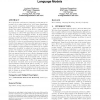63 search results - page 10 / 13 » Using context and sensory data to learn first and second per... |
BMCBI
2010
13 years 7 months ago
2010
Background: Word sense disambiguation (WSD) algorithms attempt to select the proper sense of ambiguous terms in text. Resources like the UMLS provide a reference thesaurus to be u...
GIS
2005
ACM
14 years 8 months ago
2005
ACM
Several application contexts require the ability to use together and compare different geographic datasets (maps) concerning the same or overlapping areas. This is for example the...
WSDM
2012
ACM
12 years 3 months ago
2012
ACM
Recent research has made significant advances in automatically constructing knowledge bases by extracting relational facts (e.g., Bill Clinton-presidentOf-US) from large text cor...
ISESE
2003
IEEE
14 years 22 days ago
2003
IEEE
One purpose of empirical software engineering is to enable an understanding of factors that influence software development. Surveys are an appropriate empirical strategy to gather...
CIKM
2011
Springer
12 years 7 months ago
2011
Springer
Word prediction performed by language models has an important role in many tasks as e.g. word sense disambiguation, speech recognition, hand-writing recognition, query spelling an...

